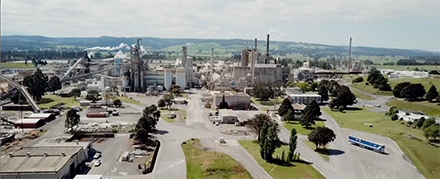Opal Australian Paper’s operations are being undermined by short, medium and long-term threats to its hardwood timber supplies under the Andrews Government’s forestry plan, according to Narracan MP Gary Blackwood, the manufacturing union and the Government itself. Source: Philip Hopkins for Timberbiz
The Government aims to close all native forest harvesting in Victoria by 2030, with an initial stepdown in the resource supply after 2024. Most hardwood operations are in Gippsland.
According to Australian Paper’s 2018 Sustainability Report, the Maryvale paper mill bought 1,654,142 tonnes of wood for its operations. Of this, 68% was sourced from plantations owned by Hancock Victorian Plantations in Gippsland, while 26% was pulpwood bought from VicForests, with hardwood sawmill residues – woodchips – supplying the remaining 6% of the resource to the paper mill.
Mr Blackwood, who is the Opposition spokesman on forestry, said the drop in timber supply to AP would start from 2024, leaving the company short of wood for its operations because the amount of pulpwood and sawmill residues would fall.
Some hardwood sawmills were bound to close after 2024 as they would not be able to buy enough timber from VicForests’ reduced resource allocation to survive, he said.
However, Mr Blackwood said the supply shortfall was already likely in the short term because of the continued failure of Environment Minister, Lily D’Ambrosio, to release the promised changes to Victoria’s code of forestry practice.
“This is threatening the survival of several Gippsland timber businesses,” he said.
Ms D’Ambrosio commissioned the review of the Code of Practice for Timber Production last July due to a spate of legal challenges against VicForests in the High Court and Victoria’s Supreme Court. She said a key aim of the review was to minimise the risk of short-term supply to processors from third-party litigation.
Ms D’Ambrosio’s office was queried whether the minister intended to release the code review but did not reply.
The legal challenges resulted in temporary bans on timber harvesting in many native forest coupes, most in the Central Highlands. VicForests’ appeal against the High Court ban, which hinges on an interpretation of the code of forestry practice, was heard in the High Court last month. It is unclear when the appeal judges will make a decision in the case.
This comes as the Government itself has admitted that its promise to transition the forestry industry from native forest to plantations by 2030 will not happen.
‘The Age’ newspaper last month revealed that Victoria’s Agriculture Minister, Mary-Anne Thomas, conceded that the promised plantations won’t be ready by 2030. Blue gums, the main hardwood timber for plantation woodchips, usually take 12-15 years to grown.
The Government has allocated $110 million for plantations in central Gippsland but to date has only planted 500 hectares. Mr Blackwood said if the Government was ‘fair dinkum’ with its promise, it would have planted 5000 hectares by now.
Without a guaranteed wood supply, Mr Blackwood said there was no way AP could proceed with its proposed waste to energy plant at Maryvale.
Opal’s general manager of public relations and sustainability, Craig Dunn, said Nippon Paper had invested $1.7 billion to create Opal, one of Australia’s leading integrated packaging businesses.
“As part of the Opal Group, our Maryvale Mill has a key role to play in providing paper for Australia’s growing fibre packaging market. Victorian Government support for plantation expansion underpins Opal’s commitment to securing the Maryvale site in the Latrobe Valley beyond 2050,” he said.
“Opal will continue to work with the Government to ensure the successful future transition of our Maryvale site to plantation-based supply. We are also continuing to pursue strategic opportunities at Maryvale in both Aquaculture and Energy form Waste, with the objective of further strengthening Maryvale’s future.”
CFMEU manufacturing national secretary Michael O’Connor said the deadline to transition out of native forest was clearly unachievable. “There is no way that any of these plantations will be ready for use by the industry in 2030 for pulping and certainly not for solid wood product manufacturing,” Mr O’Connor said.
“Pretending this scheme will provide a future for workers and timber communities is nothing more than a cruel hoax.”
A research paper presented to the Federal Government-funded Gippsland Forestry Hub last month said a proposed plantation expansion for Gippsland could not bridge the supply gap that would result from the State Government’s policy to close Victoria’s native forest industry by 2030.






